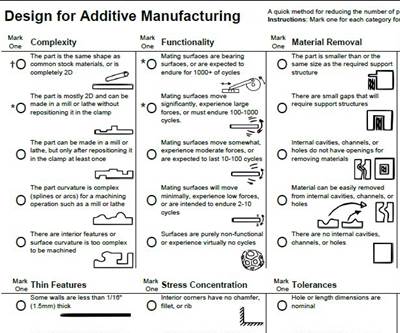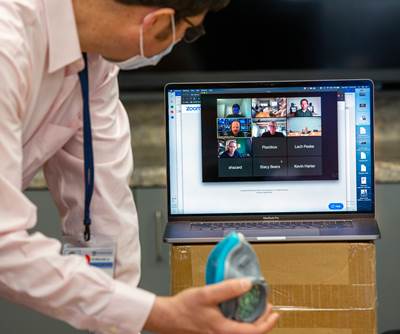Additive Manufacturing vs. COVID-19: Protecting Your Ideas for Protecting Others
Reporting from the front lines of the fight against the Coronavirus – battling liability and IP issues.
Share











Autodesk, Inc.
Featured Content
View More
A functioning stethoscope made with 3D printed parts, brake cables and aquarium tubing. Photo: Penn State MASC Initiative.
We’ve seen it happen before. Someone shares a 3D solid model of a cool design only to find that someone else has downloaded it, 3D printed it and is selling it on an e-commerce site. How would you respond if this happened to you? When it happened to Thingiverse designer Louise Driggers, she responded by posting a 3D model of a sad face, resulting in over 900 comments and dozens of others realizing similar things had happened to them. Meanwhile, Thingiverse changed their file downloading process to ensure that relevant licensing information from Creative Commons or any other open source license is prominently displayed during the download.
It should come as no surprise, then, that this persists in the age of COVID-19. Prusa was among the first to share its 3D printed face shield design for free on its website, and it did so under a non-commercial license. It asked that the shields be donated (for free) to those who needed them but also allowed for the producer to cover manufacturing costs; however, Prusa did “not want to see these shields on eBay for $50.” Well, guess where they are now? Selling on eBay and other e-commerce sites for as little as $3 and as high as $17. Granted, it isn’t $50, but still, it is definitely more than the cost of materials required to make one.
As you might imagine, Prusa’s face shield isn’t the only one suffering this fate. You can find all sorts of 3D printed personal protective equipment (PPE) on e-commerce sites right now given the scarcity of PPE in the traditional supply chain. Some of the PPE even boasts that it is “NIH approved” because it was downloaded from the NIH 3D Print Exchange. Now, is NIH going to pursue any of these sellers and prosecute them for downloading and trying to make a buck off of their hard work? Well, it depends on the license associated with the file that is downloaded. Creative Commons licenses, for instance, come in six variations depending on how the originator allows the work to be used, remixed and distributed (either commercially or non-commercially) as long as the originator is credited. If the work exists in the public domain like the JPL Performance Respirator, then anyone can take it, remix it and even sell it without permission or attribution. So while it may seem unethical, in some cases it is permissible to take someone’s design, 3D print it and sell it on an e-commerce site.
The new wrinkle in the age of COVID-19, however, deals with product liability — who is liable if someone gets injured or contracts the coronavirus while wearing 3D printed PPE? Well if you bought it on eBay, for instance, eBay is not liable for the products sold on its website thanks to Section 230 of the Communications Decency Act. So is it the seller who is liable or will the seller blame the party who created and shared the 3D CAD model — or cast the blame on NIH for hosting it on their 3D Print Exchange?
Unfortunately, the answer is not straightforward when it comes to product liability for 3D printing someone else’s CAD model or STL file. A CAD or STL file is a file, not a physical product, and if it is freely available for download, then there is no economic loss associated with its failure to perform. If the CAD or STL file is 3D printed and the user is harmed while wearing it, for instance, 3D printed PPE that fails to protect users who then contract COVID-19, then it becomes a real legal issue. The file originator better make sure they are protected. This gets into warnings and issues of indemnity (i.e., compensation paid by one party to another for any loss, damages or liability that is incurred), and it has been interesting to see how different 3D printing companies and repositories are handling this when it comes to PPE. EnvisionTEC, for instance, simply asks that you read, acknowledge and agree to the terms and conditions in its release waiver before downloading and 3D printing any of its files. HP used a similar approach initially, but now they require you to check a box to agree to HP’s terms and conditions before you can download files for 3D printing. Carbon, on the other hand, requires you to submit your contact information or be a registered user with Carbon Academy before they will share any files related to COVID-19.
So why am I telling you all this? Well, product liability, indemnification, waivers and release forms, and intellectual property (IP) have all come into play as we have scrambled to help healthcare workers address critical supply chain shortages. While PPE is high on that list, single-use stethoscopes became an issue recently as our inventory was about to run out. Supply became limited, orders faced a two-month backlog, and prices increased from $1.25 per stethoscope to nearly $6.00 each.
In search of an alternative solution, our team found the free/open source 3D printed stethoscope developed and validated by Dr. Tarek Loubani and his team in 2018. We downloaded and 3D printed the files posted on GitHub, sourced the rest of the components at a hardware store and assembled a working stethoscope within a day. It was pretty amazing to find a 3D printed solution so quickly, but we realized that we were now clearly making medical devices, not just PPE. The acoustic quality was great, but what if a patient was incorrectly diagnosed using our 3D printed stethoscope? Moreover, we certainly were not making it within a cGMP-compliant facility, and we had not registered it with the FDA (it is a Class 1 medical device); so, what was our liability? We weren’t violating anyone’s IP, and we weren’t selling the product commercially, but we were certainly exposing ourselves and the doctors to significant risks that we had not considered when 3D printing PPE.
Needless to say, we are not manufacturing 3D printed stethoscopes for use; instead, we continue to refine the design based on feedback from the doctors that test our prototypes. Meanwhile, we are talking to cGMP-compliant manufacturers that are registered with the FDA to see if any of them want to manufacture 3D printed stethoscopes, but now it is a business decision that depends on supply and demand — the cost to manufacture it versus the selling price — which changes daily thanks to the rise (or fall) of coronavirus cases.
Related Content
How to Meet Aerospace’s Material Challenges and More at IMTS
Succeeding in aerospace manufacturing requires high-performing processes paired with high-performance machine tools. IMTS can help you find both.
Read More6 Trends in Additive Manufacturing Technology
IMTS 2024 features a larger Additive Manufacturing Pavilion than ever before, with veteran suppliers alongside startups and newcomers at the front of the West Building. As you browse these exhibitors, as well as booths found elsewhere at the show, keep an eye out for these trends in AM.
Read MoreChuck Jaws Achieve 77% Weight Reduction Through 3D Printing
Alpha Precision Group (APG) has developed an innovative workholding design for faster spindle speeds through sinter-based additive manufacturing.
Read MoreA Fond Farewell to My Additive Friends
In his final “Additive Insights” column, Tim Simpson reflects on how additive manufacturing has progressed in the last six years. Standards and software are two examples.
Read MoreRead Next
How a Worksheet Can Elevate AM Success
How a simple worksheet can help improve success with additive manufacturing.
Read MoreAdditive Manufacturing Versus COVID-19: The Race for PPE
Reporting from the front lines of the fight against coronavirus — still deep in the trenches.
Read More5 Rules of Thumb for Buying CNC Machine Tools
Use these tips to carefully plan your machine tool purchases and to avoid regretting your decision later.
Read More













.png;maxWidth=150)



















.jpg;maxWidth=300;quality=90)
















